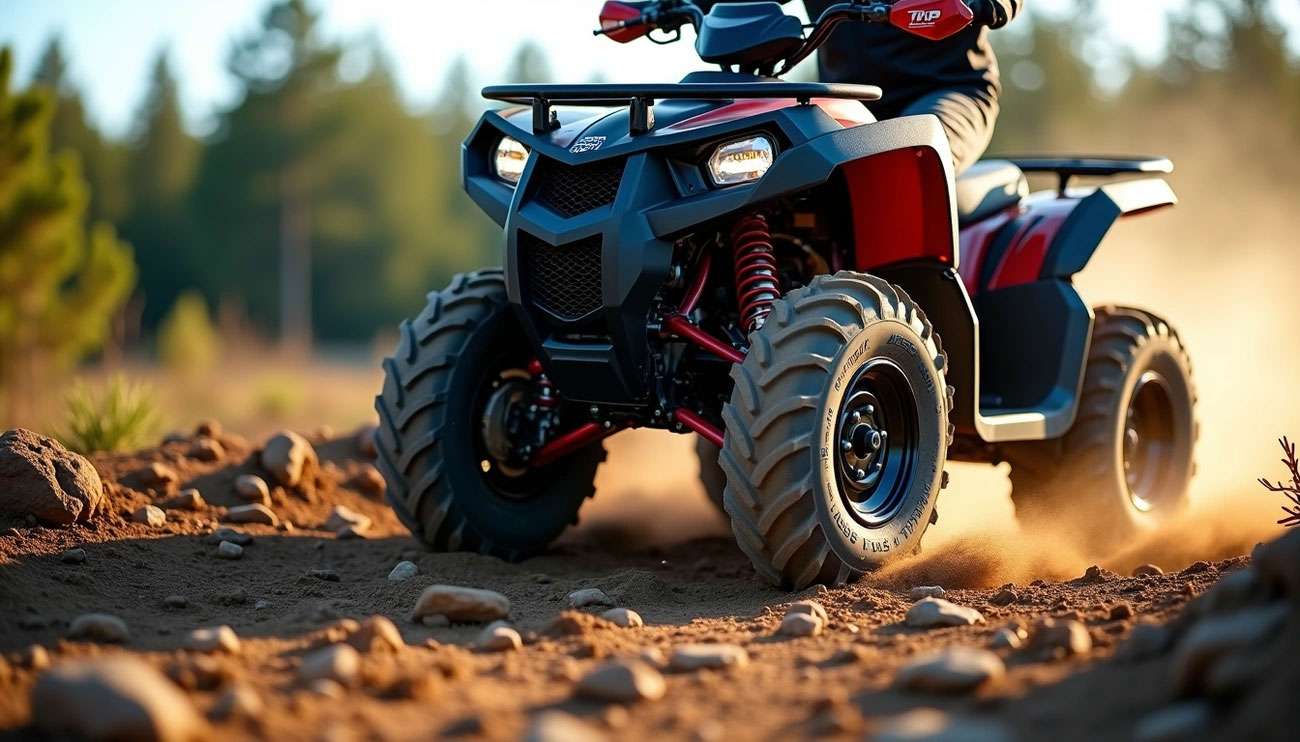
ATV riding continues to gain momentum across the country, with recreational off-road vehicles representing one of the fastest-growing segments in the U.S. market. When it comes to who makes the best ATV tires, the answer depends entirely on where you ride and how you tackle the terrain.
We've seen over 7 million tires sold by leading manufacturers, and each brand has carved out its specialty. Smart riders understand that the best ATV tires vary dramatically based on your terrain. Take rocky trails, for example - 8-ply construction becomes essential because these tires resist punctures and handle sharp rocks and debris far better than lighter alternatives. Maxxis has earned respect among serious riders for building quality tires that perform when conditions get tough, while GBC consistently delivers exceptional value without sacrificing quality.
Maybe you're after mud terrain tires with deeper lugs and reinforced sidewalls for maximum traction. Or perhaps you need versatile all-terrain options that handle everything from hardpack to loose soil. Either way, finding the right brand means understanding what each manufacturer does best.
We'll break down the top contenders, highlight what makes each brand special, and show you which terrains they dominate. Ready to find the perfect match for your riding style?
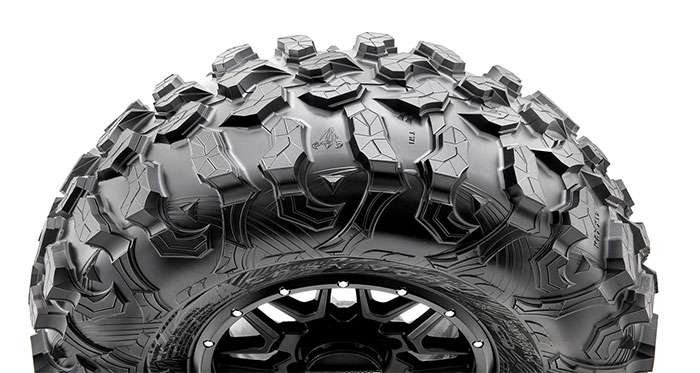
Since 1967, Maxxis has built its reputation as one of the premier ATV tire manufacturers, becoming the first tire brand to earn ISO 9001 quality certification. With manufacturing facilities across five countries and distribution reaching 180 nations worldwide, Maxxis creates high-performance tires designed to handle the most demanding riding conditions.
The Bighorn series represents Maxxis's flagship line, with the Bighorn Radial achieving legendary status among serious ATV riders. For those wanting maximum off-road capability without the weight penalty, the Bighorn 2.0 delivers the same exceptional traction through slimmer lugs while preserving the proven tread design.
The Roxxzilla has earned its place as the ultimate rock-crawling tire, specifically engineered to grip rock surfaces and power through the most challenging obstacles. When extreme terrain demands serious performance, the Carnivore stands out with its 8-ply-rated construction borrowed from light truck tire technology, delivering superior capability across mud, roots, and rocks.
Racing enthusiasts choose the RAZR XT as Maxxis's premier desert racing option, featuring high-density double steel-belted construction that maintains stability at high speeds.
Maxxis tires excel through proprietary compound formulations that create even wear patterns across the entire contact patch. This engineering ensures consistent handling characteristics throughout the tire's service life.
Several advanced technologies set Maxxis apart from competitors:
Triple Compound Technology (3C) - Different rubber densities within the same tread provide softer compounds on edges for grip and firmer compounds in the center for stability and longevity
EXO Protection - Densely woven fabric layers in vulnerable sidewall areas prevent cuts without compromising flexibility
Enhanced Sidewall Protection - Extra shoulder lugs protect both sidewall and rim from damage on rough terrain
Radial construction in models like the Bighorn provides excellent shock absorption for smoother rides over rough terrain. Most Maxxis ATV tires feature non-directional tread patterns that deliver predictable cornering performance and superior climbing ability across varied surfaces.
Pros:
Exceptional durability with all-terrain models providing 40,000 to 60,000 miles of service life
Original equipment status with major manufacturers including Arctic Cat, BRP Can-Am, Honda, John Deere, Kymco, KTM, Kawasaki, Polaris, TGB, and Yamaha
Superior rock grip and flexible sidewalls chosen by off-road racing champions
Wide footprint and innovative tread patterns improve traction and performance
Excellent shock absorption from radial construction creates smoother rides on rough terrain
Cons:
Some models develop noticeable noise after extended use, particularly the Bighorn MT762 which can develop distinctive sound after approximately 25,000 miles
Certain models may exhibit uneven wear patterns depending on driving style and maintenance
Limited availability of specific models compared to mainstream brands like Goodyear or Michelin
No mileage warranty offered on ATV tires
Premium models command higher prices than some competitors
Maxxis delivers performance comparable to premium brands at prices typically running 10-20% below those premium competitors. Pricing varies significantly based on model and size.
The Bighorn 2.0 Radial costs between USD 148.68 to USD 235.60, offering excellent value for the performance delivered. The top-tier Roxxzilla Radial commands considerably higher prices at USD 281.68 to USD 334.40, reflecting its specialized rock-crawling capabilities.
Racing applications benefit from more affordable Razr series options, with the standard Razr priced between USD 97.85 to USD 128.25. The Carnivore and Carnivore RT Radial models occupy the premium segment, ranging from USD 241.30 to USD 279.30.
Industry listings show Maxxis offers specialized models at various price points:
Rock crawling tires: USD 249.00 to USD 489.00
Desert racing tires: USD 319.00 to USD 358.00
All-terrain options: USD 246.00 to USD 388.00
Mud-specific models: USD 132.00 to USD 325.00
Each Maxxis model targets specific terrain mastery. The Bighorn series dominates all-terrain applications through its wide footprint and large shoulder lugs that protect sidewalls. This versatility makes it popular among recreational riders, ATV racers, and agricultural users who need balanced performance.
The Roxxzilla stands as the premier choice for rock crawling and technical terrain. Its design focuses specifically on gripping rock surfaces and conquering obstacles that would challenge lesser tires.
Desert racing demands call for the RAZR XT, engineered specifically for high-speed stability on hard-packed terrain. Meanwhile, the Carnivore excels when riders face aggressive trail conditions with mud, roots, and rocks requiring maximum durability.

Since 1982, ITP (Illinois Tool Works) has manufactured premium ATV and UTV tires in the United States, operating facilities in Clinton, Tennessee and Carlisle, Pennsylvania. This American manufacturer has earned recognition for producing high-performance tire models specifically designed for demanding off-road conditions.
The Mud Lite Series represents ITP's cornerstone product line, with specific variants engineered for different terrain challenges. The original Mud Lite excels in wet conditions and muddy terrain through its unique lug design.
For riders seeking a radial construction option, the Mud Lite XTR delivers extended tread life and proven mud performance. The Coyote Radial stands out as ITP's premium all-terrain option, featuring 8-ply rated radial construction with the patented RG2 soft compound that adapts across varied surfaces.
The Terra Hook offers an aggressive tread pattern specifically designed to grip loose surfaces while self-cleaning to prevent mud buildup. Racing applications benefit from the Holeshot series, engineered to provide maximum acceleration and cornering grip on tracks and trails.
ITP tires distinguish themselves through several proprietary technologies that enhance performance:
8-ply rated radial construction - Balances durability with a smooth ride quality
RG2 soft compound - A proprietary rubber blend that maintains flexibility across temperature ranges while providing excellent traction
Staggered shoulder lugs - Create optimal cornering traction and improve side-bite on loose terrain
Self-cleaning tread channels - Prevent mud packing and maintain consistent performance
The Mud Lite line features radial construction that reduces rolling resistance while improving shock absorption. Most ITP models utilize computer-designed tread patterns optimized for specific terrain types.
Pros:
Exceptional durability with users reporting impressive longevity across various terrain types
Superior snow and mud traction, particularly in the Mud Lite series
Made in USA with manufacturing facilities in Tennessee and Pennsylvania
Excellent value for money compared to premium competitors
Wide product range covering all terrain types and riding styles
Cons:
Some models run heavier than competitors, potentially affecting handling
Premium specialty models like the Coyote Radial command higher prices
Users occasionally report potential rim leaks requiring attention
Limited international availability compared to global brands
ITP positions their tires competitively, offering American-made quality at prices that challenge import brands. The flagship Coyote Radial ranges from USD 167.88 to USD 254.88, reflecting its 8-ply radial construction and advanced RG2 compound.
The proven Mud Lite series maintains more accessible pricing between USD 81.44 to USD 168.31, making premium mud performance available to budget-conscious riders. The Mud Lite XTR, featuring extended tread life, costs USD 108.00 to USD 191.00.
Specialized models occupy different price segments:
Terra Hook: USD 153.56 to USD 191.81
Holeshot racing tires: USD 66.75 to USD 128.06
Mud Lite AT: USD 140.00 to USD 213.00
ITP tires excel across multiple terrain applications. The Mud Lite series dominates wet and muddy conditions, making it the preferred choice for trail riders who regularly encounter challenging terrain and water crossings.
The Coyote Radial serves riders seeking true all-terrain versatility, handling everything from hardpack trails to loose sand with equal confidence. Its 8-ply construction provides the durability needed for aggressive riding while maintaining comfort.
Racing applications benefit from the Holeshot series, engineered specifically for maximum acceleration and cornering grip on tracks. The Terra Hook addresses the needs of riders facing loose surfaces and requiring aggressive self-cleaning capability.
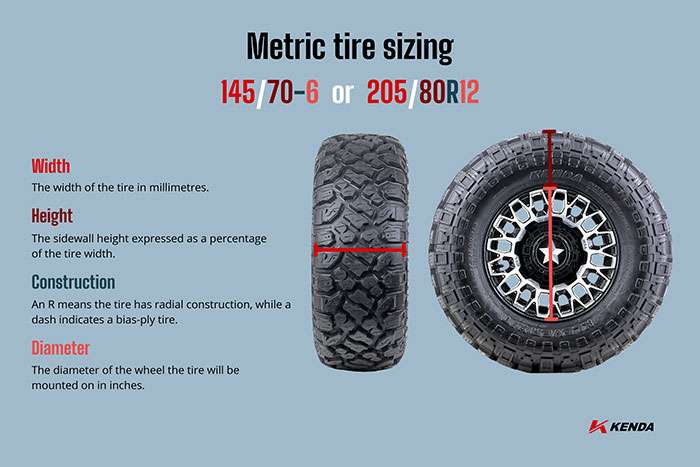
Since 1962, Kenda has manufactured tires serving multiple vehicle segments, including a significant presence in the ATV market. This global manufacturer produces tires known for balancing affordability with dependable performance across varied terrain conditions.
The Bearclaw HTR K587 represents Kenda's flagship ATV offering, specifically engineered to handle both wet and dry conditions. The original Bearclaw established the foundation, delivering reliable performance through its distinctive claw-pattern tread design that grips varied surfaces.
The Bearclaw EVO K592 advances the proven design with deeper lugs and enhanced sidewall protection for aggressive terrain. The Mastodon HT builds on this lineage, offering highway-terrain capability while maintaining the brand's signature durability.
For winter conditions, the K538 Executioner features specialized tread blocks designed specifically for snow and ice traction. The Bounty Hunter provides an aggressive all-terrain option with self-cleaning channels that prevent mud buildup.
Kenda tires incorporate several technologies that distinguish their performance characteristics:
Deep sipes technology - Multiple thin slits in the tread blocks create additional biting edges for enhanced traction on slippery surfaces
Advanced silica material - Improves flexibility in cold conditions while maintaining durability
Self-cleaning tread channels - Designed to evacuate mud and debris for consistent performance
Reinforced sidewall construction - Protects against punctures and cuts in rough terrain
The Bearclaw series features a non-directional tread pattern that simplifies rotation and extends tire life. Most Kenda ATV models utilize a 6-ply rating that balances weight with puncture resistance.
Pros:
Affordable pricing makes quality ATV tires accessible to budget-conscious riders
Strong construction delivers reliable performance across varied conditions
Excellent wet and dry traction, particularly in the Bearclaw HTR series
Wide availability through multiple distribution channels
Winter-specific options like the K538 provide specialized cold-weather capability
Cons:
More road noise compared to premium brands, particularly on hard surfaces
Limited high-performance options for specialized racing applications
Some users report variable tire wear depending on riding style
Tread compounds may wear faster than premium alternatives in extreme conditions
Kenda positions their tires as value-oriented options without sacrificing essential performance. The Bearclaw HTR K587 starts at USD 131.96, making it one of the most affordable premium-featured ATV tires available.
The Bearclaw EVO K592 commands slightly higher prices at USD 132.50 to USD 204.00, reflecting its enhanced tread depth and sidewall protection. Winter-specific models like the K538 Executioner range from USD 91.78 to USD 95.19.
Other notable models price as follows:
Mastodon HT: USD 171.95 to USD 240.19
Bounty Hunter: USD 81.44 to USD 140.25
Original Bearclaw: USD 71.25 to USD 176.44
Kenda tires serve riders seeking dependable performance without premium pricing. The Bearclaw HTR excels in winter conditions and year-round riding where wet traction matters most.
Budget-conscious trail riders benefit from the original Bearclaw's proven design that handles mixed terrain effectively. The model works well for recreational riders who need reliable performance without specialized racing features.
The Bounty Hunter addresses aggressive trail riding needs with self-cleaning capability for muddy conditions. Meanwhile, the Mastodon HT serves utility riders who need highway-capable tires that can handle occasional off-road use.
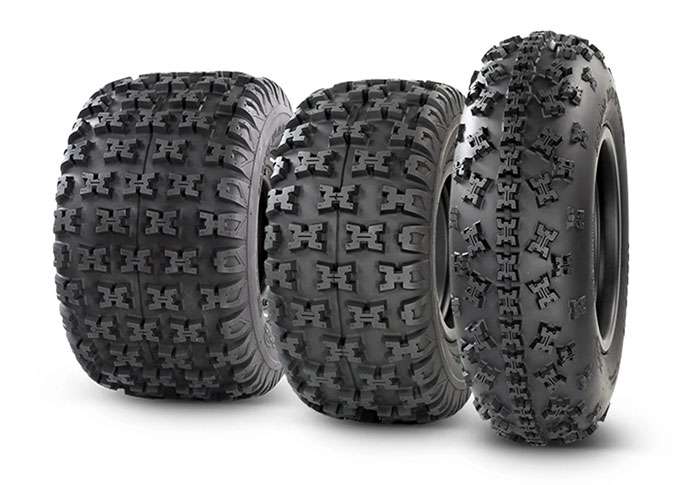
GBC has manufactured off-road tires since its founding, establishing a reputation for building some of the most durable ATV tires available. This American manufacturer focuses specifically on powersports applications, creating tires engineered for extreme terrain and demanding riding conditions.
The Kanati Mongrel represents GBC's flagship offering, featuring aggressive tread design with deep lugs that excel across multiple terrain types. The Dirt Devil delivers lightweight performance for riders prioritizing acceleration and handling.
For extreme mud conditions, the Grim Reaper provides massive paddle-style lugs that power through the deepest bogs. The Dirt Commander offers versatile all-terrain capability with a more conservative tread pattern suitable for mixed-use applications.
Racing applications benefit from the Ground Buster series, engineered specifically for maximum traction and predictable handling at high speeds. The Afterburn combines street-legal capability with off-road performance for riders needing dual-purpose tires.
GBC incorporates advanced engineering throughout their tire lineup:
Advanced rubber compounds - Formulated to resist cuts and punctures while maintaining flexibility
Specialized tread designs - Computer-optimized patterns for specific terrain types
Multiple ply ratings - Options from 6-ply to 10-ply construction for varying durability needs
Reinforced sidewall construction - Extra protection in vulnerable areas reduces puncture risk
The Mongrel series features an aggressive tread pattern with sipes that create additional biting edges for improved traction. Most GBC models utilize directional tread designs optimized for forward momentum and self-cleaning.
Pros:
Exceptional durability with 10-ply options for extreme terrain
Versatile terrain capability across the product line
Made in USA with American manufacturing
Strong performance in extreme conditions that challenge other brands
Excellent value considering durability and performance
Cons:
Higher pricing compared to budget brands
Some models generate increased noise on hardpack surfaces
Limited model availability through some retailers
Heavier weight in extreme-duty models may affect handling
GBC positions their tires as premium options with pricing reflecting their extreme-duty construction. The Kanati Mongrel ranges from USD 291.62 for standard sizes, with the 10-ply Mongrel SQ commanding premium prices.
The Dirt Devil provides more accessible entry at USD 71.44 to USD 153.19, making it GBC's most budget-friendly option. The Grim Reaper occupies the specialty segment at USD 112.13 to USD 191.00, reflecting its extreme mud capability.
Other models price as follows:
Dirt Commander: USD 95.81 to USD 191.06
Ground Buster: USD 77.69 to USD 140.44
Afterburn: USD 108.13 to USD 204.00
GBC tires excel when extreme durability becomes essential. The Kanati Mongrel dominates aggressive trail riding where puncture resistance and sidewall strength matter most.
The Grim Reaper addresses extreme mud riding needs, providing the aggressive tread required for powering through deep bogs and muddy trails. Racers benefit from the Ground Buster's high-speed stability and predictable handling characteristics.
The Dirt Commander serves riders seeking versatile all-terrain capability without extreme specialization. Meanwhile, the Afterburn fills a unique niche for riders needing tires that handle both street and trail use.
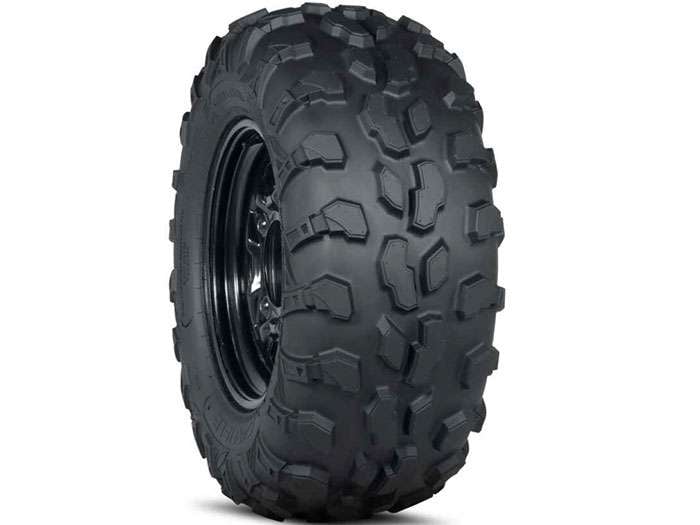
Carlisle has manufactured tires in the United States since 1917, becoming one of the most recognized names in specialty tire production. Operating facilities in Tennessee and Pennsylvania, Carlisle produces ATV tires known for dependable performance and long service life.
The AT489 represents Carlisle's most popular ATV tire, featuring an all-purpose tread design that handles varied terrain effectively. The Trail Wolf delivers aggressive trail capability with deeper lugs for enhanced traction.
For riders seeking maximum traction, the ACT HD features an aggressive tread pattern with reinforced construction. The All Trail provides versatile performance across different surfaces while maintaining smooth ride quality.
Utility applications benefit from the Turf Saver, designed to minimize ground disturbance while providing traction. The Black Rock serves extreme terrain needs with heavy-duty construction and aggressive tread design.
Carlisle tires incorporate proven technologies that deliver reliable performance:
All-purpose tread designs - Versatile patterns handle multiple terrain types
Self-cleaning tread channels - Prevent mud and debris buildup
Terrain-specific engineering - Models optimized for particular surface conditions
Multiple ply ratings - Options from 2-ply to 6-ply construction
The AT489 features a non-directional tread pattern that extends tire life through even wear. Most Carlisle models utilize proven rubber compounds that balance durability with ride comfort.
Pros:
Long-lasting durability with many users reporting years of reliable service
Strong value proposition with competitive pricing
Made in USA with domestic manufacturing
Wide availability as OEM replacement options
Proven track record across multiple decades
Cons:
More road noise on hard surfaces compared to premium competitors
Limited high-performance options for specialized applications
Some models exhibit poor mud clearing at low speeds
Tread compounds may not match premium brands in extreme conditions
Carlisle positions their tires as value-focused options with pricing that appeals to practical riders. The AT489 ranges from USD 131.35 to USD 168.14, making it an affordable all-terrain choice.
The Trail Wolf maintains accessible pricing at USD 81.56 to USD 153.31, providing aggressive capability without premium costs. The ACT HD commands slightly higher prices at USD 97.88 to USD 178.50 for its enhanced construction.
Other models price as follows:
All Trail: USD 76.50 to USD 140.44
Turf Saver: USD 61.75 to USD 128.00
Black Rock: USD 106.44 to USD 191.00
Carlisle tires serve riders seeking dependable OEM-replacement quality without specialized features. The AT489 excels as a versatile all-terrain option for recreational trail riding and utility work.
The Trail Wolf addresses more aggressive trail needs while maintaining reasonable pricing. Utility riders benefit from the Turf Saver's minimal ground disturbance for yard work and property maintenance.
The ACT HD fills the need for enhanced traction in challenging terrain without moving into premium pricing territory. Meanwhile, the Black Rock serves riders facing extreme terrain who need heavy-duty construction.
Brand |
Flagship Model |
Key Features |
Manufacturing Location |
Price Range (Flagship) |
Best Use Case |
Notable Pros |
Notable Cons |
|---|---|---|---|---|---|---|---|
Maxxis |
Bighorn Series |
- Triple Compound Technology (3C) |
Five countries worldwide |
$148.68 - $235.60 (Bighorn 2.0) |
All-terrain, versatile use for recreational, racing, and agricultural |
- 40,000-60,000 mile service life |
- Noticeable noise after extended use |
ITP |
Mud Lite Series |
- 8-ply rated radial construction |
USA (Clinton, TN & Carlisle, PA) |
$167.88 - $254.88 (Coyote Radial) |
Multi-terrain with excellent mud performance |
- Exceptional durability |
- Heavier than competitors |
Kenda |
Bearclaw HTR K587 |
- Deep sipes technology |
Not mentioned |
$131.96+ (Bearclaw HTR) |
Winter conditions and varied terrain |
- Affordable pricing |
- More road noise |
GBC |
Kanati Mongrel |
- Advanced rubber compounds |
USA |
$291.62+ (Mongrel SQ) |
Extreme off-road and varied terrain |
- Exceptional durability |
- Higher pricing |
Carlisle |
AT489 |
- All-Purpose designs |
USA (Tennessee & Pennsylvania) |
$131.35 - $168.14 (AT489) |
OEM replacement and utility work |
- Long-lasting durability |
- More road noise |
This comparison shows clear patterns. Maxxis delivers the best all-around performance with proven durability. ITP dominates mud terrain applications with superior traction. Kenda offers excellent value for winter riding conditions. GBC excels in extreme terrain situations. Carlisle provides reliable OEM-quality replacements at competitive prices.
Your choice comes down to matching these strengths with your riding style and terrain demands.
Selecting the right ATV tires comes down to matching your terrain needs with each brand's strengths. We've shown you how Maxxis delivers outstanding all-terrain versatility with their Bighorn series, while ITP owns the mud with their aggressive tread patterns. Kenda offers solid winter performance at budget-friendly prices, GBC builds extreme durability for serious off-roaders, and Carlisle provides dependable OEM-quality options without breaking the bank.
Your riding terrain should drive your decision. Rocky trails demand 8-ply construction to resist punctures and handle sharp debris. Mud riding calls for aggressive, self-cleaning tread patterns that won't pack up. Winter riders benefit from deep sipes and specialized compounds like those found in the Kenda Bearclaw HTR.
Each manufacturer has found their sweet spot. American-made options from ITP, GBC, and Carlisle appeal to riders who value domestic production, while Maxxis brings global engineering expertise across multiple price points.
Ready to upgrade your ride? Find the best selection of ATV tires at Performance Plus Tire, where you can compare options across all these leading brands.
Your ATV deserves tires that match your riding style and handle the challenges you'll face on every trail. Whether you prioritize durability, traction, comfort, or value, you now have the knowledge to make a smart choice that will keep you rolling for thousands of miles ahead.
Selecting the right ATV tires requires matching your specific terrain needs with the right brand's strengths for optimal performance and safety.
Maxxis Bighorn series leads all-terrain versatility with 40,000-60,000 mile durability and Triple Compound Technology for balanced performance across varied conditions.
ITP dominates mud performance with their Mud Lite series featuring 8-ply radial construction and superior traction in challenging wet conditions.
8-ply construction is essential for rocky terrain as it provides puncture resistance and durability when riding over sharp rocks and debris.
Kenda offers exceptional winter performance value with deep sipes technology in the Bearclaw HTR series at affordable pricing compared to premium competitors.
American-made options from ITP, GBC, and Carlisle provide quality construction with domestic manufacturing for riders prioritizing USA-made products.
The key to maximizing your ATV experience lies in understanding that different terrains demand specific tire technologies - from aggressive tread patterns for mud to reinforced sidewalls for rock crawling. Each brand has developed specialized expertise, making terrain-specific selection more important than brand loyalty alone.
When selecting ATV tires, consider your primary riding terrain, desired tread pattern, tire construction (ply rating), and budget. Matching the tire to your specific needs and riding conditions is crucial for optimal performance and safety.
Not necessarily. While premium tires often offer advanced features and durability, many mid-range options provide excellent performance for most riders. Consider your specific needs and usage to determine the best value for your situation.
The lifespan of ATV tires varies depending on usage, terrain, and maintenance. Generally, tires should be replaced when the tread depth reaches 1/8 inch or if there's visible damage. Some high-quality tires can last 40,000-60,000 miles under proper conditions.
Radial tires offer better traction, a smoother ride, and longer tread life, making them ideal for high-speed and long-distance riding. Bias-ply tires are typically more durable and puncture-resistant, making them suitable for rough terrain and heavy-duty applications.
No, it's not recommended to use car tires on ATVs. ATV tires are specifically designed for off-road use with unique tread patterns, construction, and sizing to handle the demands of all-terrain vehicles. Using car tires could compromise safety and performance.